suspension AUDI A8 2014 Owners Manual
[x] Cancel search | Manufacturer: AUDI, Model Year: 2014, Model line: A8, Model: AUDI A8 2014Pages: 314, PDF Size: 78.47 MB
Page 14 of 314

12 Instruments and warning/indicator lights
Some indicators lights in the disp lay can turn
on in several colors.
A WARNING
- Failure to heed warning lights and other
important vehicle information may result
in serious personal injury or vehicle dam
age.
- Whenever stalled or stopped for repair,
move the vehicle a safe distance off the
road, stop the engine, and turn on the
emergency flasher¢ page 47.
- The engine compartment of any motor
vehicle is a potentially hazardous area.
Before you check anything in the engine
compartment, stop the engine and let it
cool down. Always exerc ise extreme cau
t ion when work ing under the hood
¢ page 231, Working in the engine
compartment
(D Tips
Malfunctions or faults will be identified e i
ther with a red symbo l (pr iority 1 = Dan
ger!) or with a ye llow symbol (priority 2 -
Warning).
Overview
Some ind icator lights turn on briefly to check
the function of that system when you switch
the ign ition on . These systems are marked
with an../ in the follow ing tables . If one of
these ind icator lights does not turn on, there
is a malfunction in that system.
Red indicator lights
Red symbols indicate a priority malfunction -
Danger!
- Pull off the road .
- Stop the vehicle .
- T urn off the engine.
- Check the malfunctioning system. Contact
yo ur author ized Aud i dealer or a quali fied
workshop for assistance.
USA models :
Brake malfunction../
¢ page 14
Canada models:
Brake malfunction../
¢ page 14
USA models:
Electromechan ica l park ing brake
¢ page 15
Canada models:
Electromechan ical park ing brake
¢ page 15
Eng ine cooling system
¢ page 16
Eng ine o il pressure
¢ page 17
Eng ine o il level
¢ page 17
Battery
¢ page 16
Safety belt
¢page 16
Electronic steering column lock
¢ page 17
E ngine start system
¢ page 18
Central ind icator light
¢ page 18
USA models : Speed warning sys
tem
¢ page 91
Canada models: Speed warning
system
¢ page 91
Adaptive cruise control./
¢ page
96
Air suspension*
¢ page 18
Pedestrian warning*
¢ page 113
Page 16 of 314

14 Instruments and warning/indicator lights
•
a
Ad Bluel;>
Ad Blue../'
Aud i lane assist*
¢ page 103
Transmission ¢page 120
Transmission ¢ page 120
Electronic steering column lock
¢ page 17
Engine start system
¢ page 18
Central indicator light
¢page 18
Dynamic steering*./
¢ page 22
Air suspension* ¢ page 18
Sport differentia l*
¢ page 23
Re fill Ad Blue*
¢ page
227
AdBlue malfunction*
¢page
227
Other indicator lights
CRUISE
•
Iii
•
I
•
Turn s ignals
¢ page 23
USA models: Cruise control*
¢ page 91
Canada models : Cruise control*
¢ page 91
Adaptive cru ise control*
¢ page96
Adaptive cru ise control*
c:> page96
Adaptive cru ise contro l*
c:>page96
Audi lane assist* ¢ page 103
•
•
Start-Stop-System*
¢ page88
Start-Stop-System*
¢page88 High beam
¢ page48
BRAKE /((f) ) Brake system
The light illuminates when the ignition is
switched on .
It goes out afte r the engine has
been started . This indicates that the brake
warning light is functioning properly.
If the brake warning light does not light up
when the engine is cranking, there may be a
malfunction in the electrical system . In this
case, contact your Audi dealer.
If the brake system warn ing/indicator light
turns on, there is a brake system ma lfunction.
1111 ( USA models) /. (Canada models)
Stop vehicle and check brake fluid level
If the indicator light turns on and the mes
sage appears, proceed as follows:
.. Pull off the road.
.. Stop the vehicle .
.. Turn off the engine .
.. Check the brake fluid level
c::> page 242.
.,. Contact your nearest authorized repair fa-
cility if necessary.
Warning! Fault in brake system. Contact
dealer
If the ABS ind icator light (I] (USA mode ls)/
(I] (Canada models), the ESC ind icator light
Ji! and the brake system indicator light
1111 (USA models)/ . (Canada models) turn
o n and the message appears, the ABS, ESC
and braking distr ibution are not working ¢_& .
Carefully drive to your author ized Audi dealer
immediately to have the malfunct ion correct-
ed ¢_& . .,.
Page 20 of 314
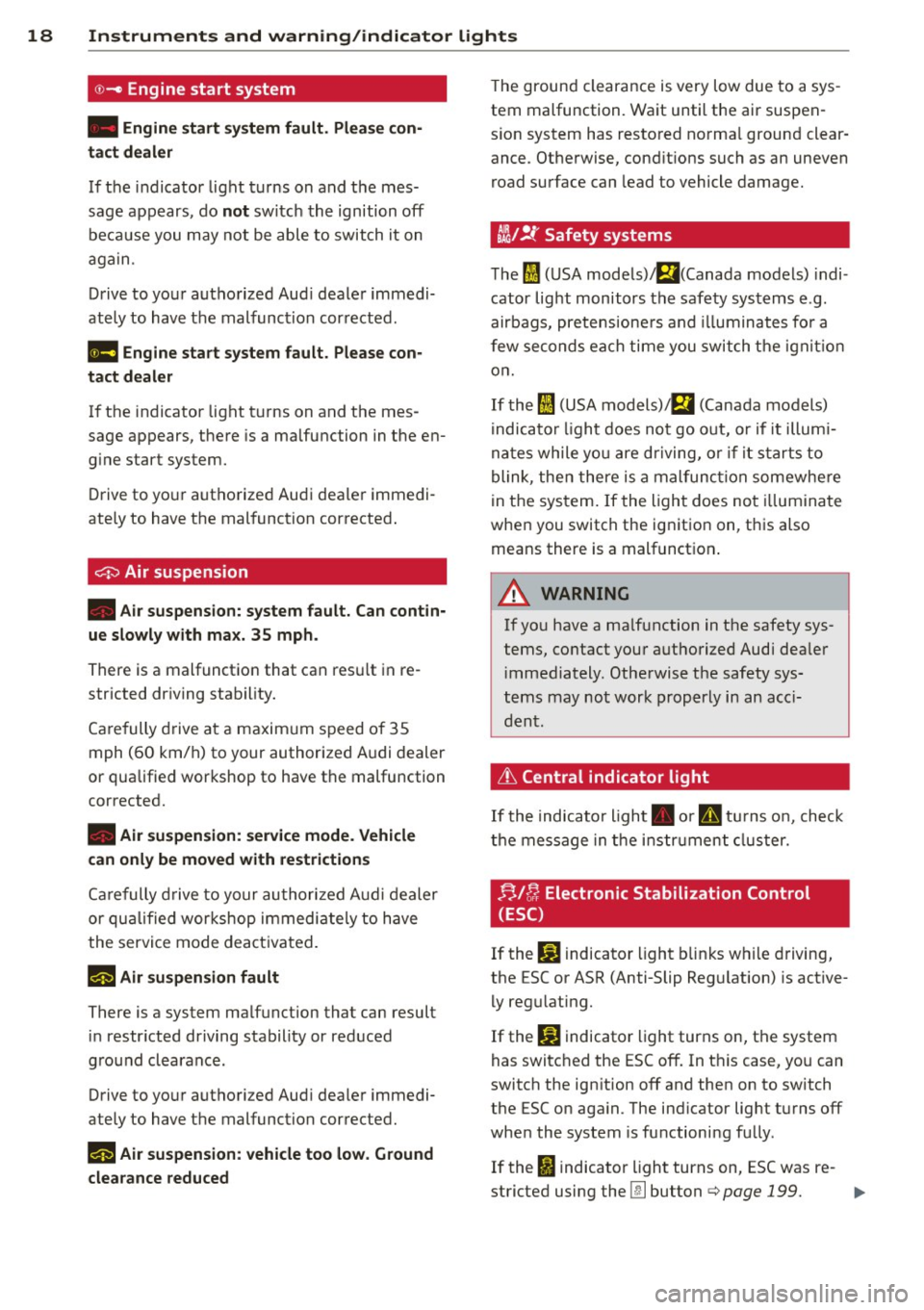
18 Instruments and warning/indicator lights
©-Engine start system
• Engine start sy stem fault. Please con
tact dealer
If t h e in dicator light turns on and the mes
sage appears, do
not sw itch the ignition off
be cause you may not be able to switch it on
aga in .
D rive to you r autho rized Aud i deale r immedi
ate ly to hav e th e malfunction corrected.
11111 Engine start system fault. Please con
tact dealer
If the indicator light t urns on and the mes
sage appears, there is a ma lfunction in the en
g ine start system.
D rive to yo ur autho rize d Au di dea le r immedi
ate ly to have t he mal function cor rected .
0 Air suspension
• Air suspension: system fault. Can cont in
ue slowly with max. 35 mph .
There is a malfunctio n that can res ult in re
stricted dr iving stability.
Ca re fully d rive a t a maxim um s peed o f 35
mph ( 60 km/h) to your author ized A udi dealer
or qua lified wor kshop to have the malfunction
corrected.
• Air suspension: service mode. Vehicle
can only be moved with restrictions
Ca re fully drive to your au thori zed A udi d ealer
or quali fied wor kshop immedi ate ly to have
the servi ce mode deac tiva ted.
l!IJ Air suspension fault
There is a system ma lfunction that can result
in restr icted dr iving stability or red uced
g ro und cleara nce.
Drive to yo ur authorized Aud i dealer immedi
ately to have t he malfunction corrected .
l!IJ Air suspension: vehicle too low. Ground
clearance reduced
T he groun d clearance is very low due to a sys
tem malfunction. Wa it until the air suspen
s io n system has resto red no rma l ground clear
ance. Ot herwise, cond it ions such as an uneven
road surface can lead to vehicle damage.
tli1!.t Safety systems
T he fl (U SA models)/ El(Canada models) indi
cator lig ht monitors the safety sys tems e .g.
airbags , p retens ione rs and illuminates fo r a
f ew seco nds ea ch time y ou swit ch t he ign ition
o n .
If th e
I (USA mod els)/ EI (Can ada models)
i ndica to r li ght does no t go o ut, or if it illum i
n at es while yo u are d riving, o r if it start s to
blink, the n t here is a m alf u nctio n somewhe re
in the sys tem . If the ligh t does no t illumina te
whe n you switch the ig nitio n on, t his also
means there is a mal funct ion .
A WARNING ....._
If yo u have a ma lf u nction in t he safety sys
tems, contact you r auth orized Audi dea le r
immedia tely. Othe rwise t he safety sys
t ems may not work properly i n an acc i
d en t.
~ Central indicator light
If th e indicato r light . or D tur ns o n, check
th e m essage in th e i nstru men t cluster.
F!,J [}; Electronic Stabilization Control
(ESC)
If the bl indicator light b links w hile d riving,
the ESC or AS R (Anti-Slip Re gulation) is active
ly reg ulating.
If the
bl indicator light turns on , th e system
has switc hed the ESC off . In t his case, yo u can
switch the ign ition off and then on to switch
the ESC o n aga in. The ind icator lig ht tu rns off
whe n the system is functioni ng fu lly.
If the
fl indicato r light turns on, ESC was re-
stricted using the
[!I button ¢ page 199. ..,.
Page 112 of 314
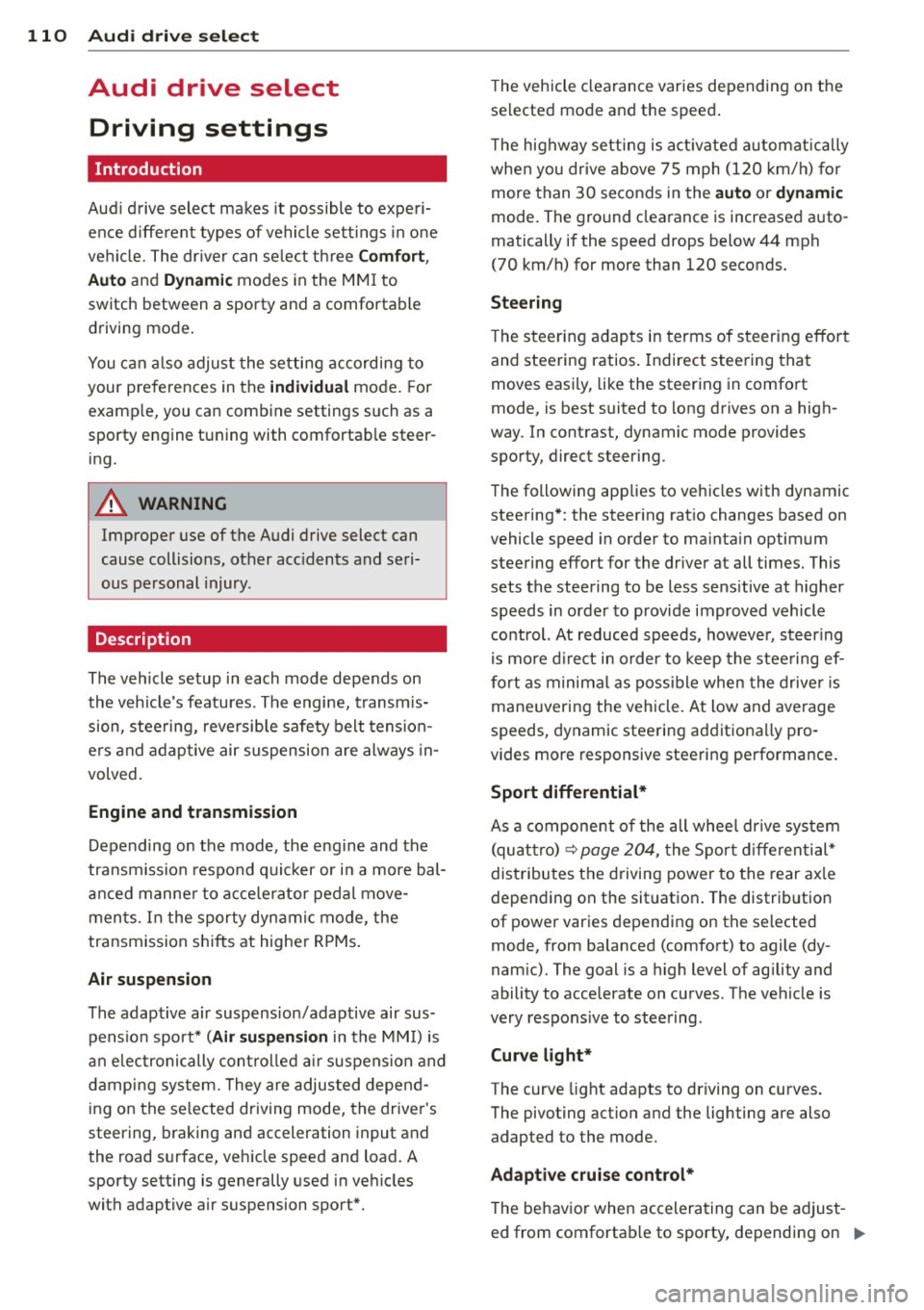
110 Audi drive select
Audi drive select
Driving settings
Introduction
Aud i d rive select mak es it possible to expe ri
ence diffe ren t types of vehi cle se ttin gs i n o ne
ve hicl e. The dr ive r can se lect th ree
Comfort ,
Auto
and Dynamic modes in the M MI to
switch between a sporty and a comforta ble
driving mo de.
You c an a lso a djust the setti ng according to
your p re ferences in the
individual mo de. For
examp le, you ca n combine settings such as a
sporty en gine t uning with comfortab le steer
ing.
A WARNING
Improper use of the A udi drive select can
cause collisions, ot her acc idents and se ri
ous pe rsonal injury.
Description
The vehicle setup in each mode depends on
the veh icl e's featu res. The engine, t ransm is
sion, stee ring, reve rsible sa fe ty belt tension
e rs a nd adap tive air su spension are alw ays in
volved.
Engine and transmission
Depending on the mode, the e ng ine and the
tra nsmission respond quic ker or i n a more bal
an ced manne r to acce le rator pedal move
men ts. In the sporty dyn ami c mode, the
tra nsmission sh ifts at highe r RP Ms.
Air suspension
The adaptive air suspens ion/adaptive air sus
pe nsion spor t*
(Air suspension in the MM I) is
an elec tronic ally con trolled air suspensio n and
da mpi ng sys tem. They are adjus ted depend
ing on the se lected driving mode, the drive r's
steering, braking and acceleration input and
the road s urface, ve hicle speed and load. A
sporty setting is generally used i n ve hicles
with adaptive air suspension sport*. T
he vehicle clea rance varies depending on the
se lected mo de an d the speed .
T he highw ay setting is activate d automatically
whe n you dr ive above 7 5 mph (120 km/ h) for
more than
3 0 seconds in the auto or dynamic
mode. The gro und clea rance is increased a uto
matically if the speed drops below
44 mph
(70 km/h) for more than 120 seconds.
Steering
T he s teering adap ts i n t erms of s teer ing effor t
and stee ring ratios . Indirect stee ring that
moves easily, like the steer ing in comfo rt
mode, is best suited to long drives on a high
way. In contrast, dynamic mode provides
sporty, direct steer ing .
The following app lies to vehi cles with dynamic
stee ring* : the steer ing rat io changes based on
vehicle speed in order to ma inta in optimum
steering effort for the drive r at all times. This
sets the stee ring to be less sens itive at h igher
s p eeds in order to provide improved vehicl e
control. At r educed speeds, howeve r, steer ing
is mo re dir ect i n order to keep the stee ring ef
f o rt as minima l as po ssible when the drive r is
mane uveri ng the veh icle. At low and average
speeds, dynamic steering ad dit iona lly pro
vides more responsive steering pe rformance .
Sport differential*
As a compone nt o f the all whee l dr ive system
(quat tro)
r:!> page 204, the Spor t differen tia l*
dis tributes t he d riving power to the rear ax le
depen ding on the sit uat io n. The distrib ution
of power var ies depending on the se lected
mode, from ba lanced (comfort) to agile (dy
nam ic). The goal is a high level of agility and
ability to accelerate on curves . The vehicle is
very res pons ive to stee ring .
Curve light*
The curve light adapts to driving on curves.
The pivoting act ion and the lighting are also
adapted to the mode.
Adaptive cruise control*
T he be hav ior when ac celera ting can be adjust
ed from comforta ble to sporty, de pending on ..,.
Page 113 of 314
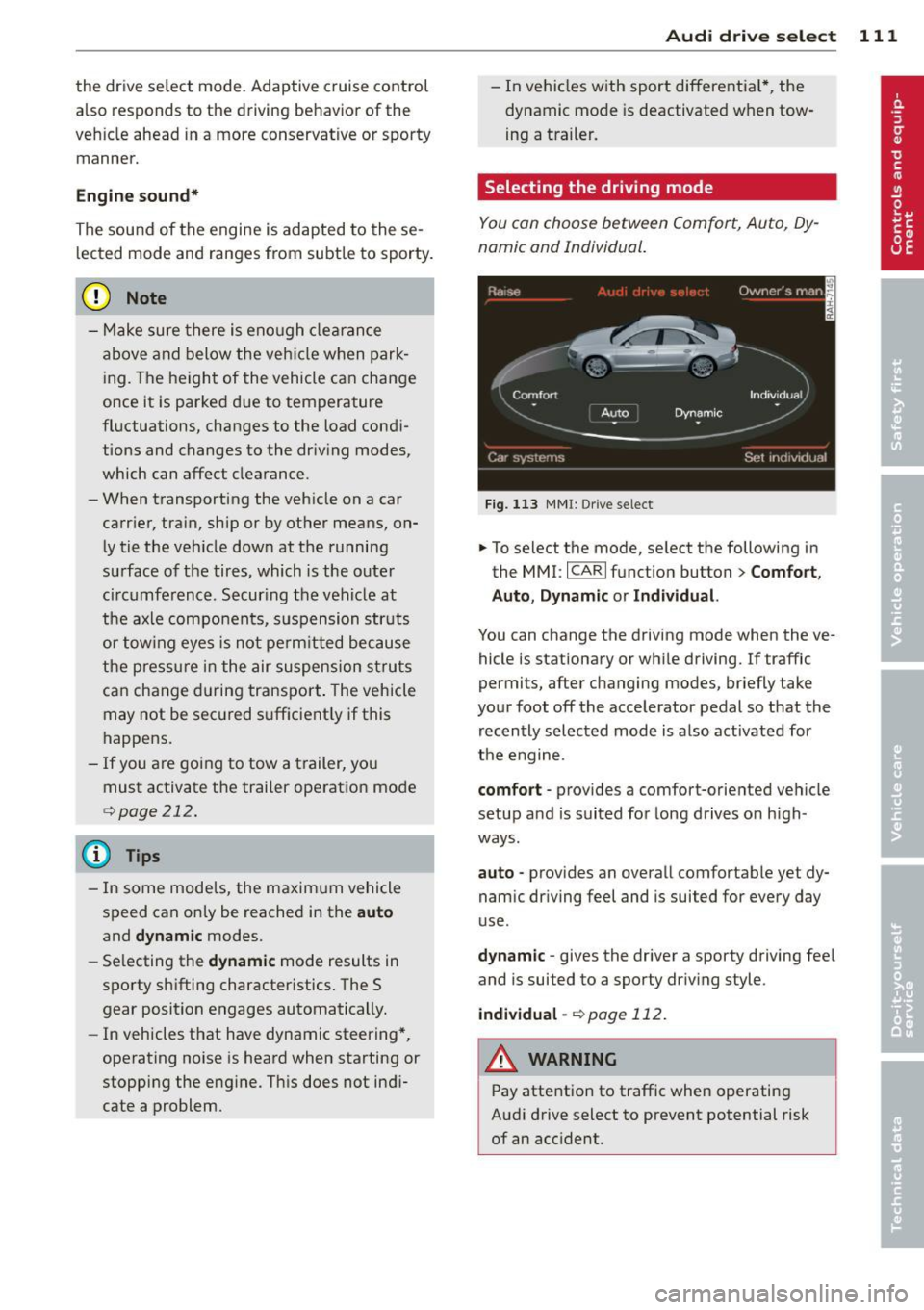
the drive select mode. Adaptive cruise control
also responds to the driving behavior of the
veh icle ahead in a more conservative or sporty
manner.
Engine sound*
The sound of the engine is adapted to the se
l ected mode and ranges from subtle to sporty.
(D Note
- Make sure there is enough clearance
above and below the vehicle when park
i ng. The height of the vehicle can change
once it is parked due to temperature
fluctuations, changes to the load cond i
tions and changes to the dr iv ing modes,
which can affect clearance.
- When transporting the veh icle on a car
carrier, tra in, ship or by other means, on
ly tie the veh icle down at the running
surface of the tires, which is the outer
circumference. Secur ing the vehicle at
the axle components, s uspension struts
or towing eyes is not permitted because
the pressure in the air suspension struts
can change during transport . The vehicle
may not be sec ured s ufficient ly if this
happens.
- If you are going to tow a trailer, you
must activate the trailer operation mode
C? poge 212.
@ Tips
- In some models, the maximum vehicle
speed can only be reached in the
auto
and dynamic modes.
- Selecting the
dynamic mode results in
sporty shifting characteristics . The S
gear position engages automatically.
- In vehicles that have dynamic steering*,
operating noise is heard when starting or
stopping the engine. Th is does not indi
cate a problem.
Audi drive select 111
-In vehicles w ith sport differential*, the
dynamic mode is deactivated when tow
ing a trailer.
Selecting the driving mode
You con choose between Comfort, Auto, Dy
namic and Individual.
Fig . 1 13 MMI: Drive select
.,. To select the mode, se lect the following in
the MMI:
I CARI f unction button > Comfort,
Auto , Dynamic
or Individual.
You can change the driving mode when the ve
hicle is stationary or wh ile driving. If traffic
permits, after changing modes, briefly take
your foot off the accelerator pedal so that the
recently selected mode is also activated for
the engine.
comfort -provides a comfort-oriented ve hicle
setup and is suited for long drives on h igh
ways .
auto -provides an overall comfortable yet dy
namic dr iving feel and is suited for every day
use.
dynamic -gives the driver a sporty driving fee l
and is suited to a sporty driv ing style.
individual-¢page 112.
A WARNING
Pay attention to traffic when operating
Audi drive select to prevent potential risk
of an accident.
Page 114 of 314
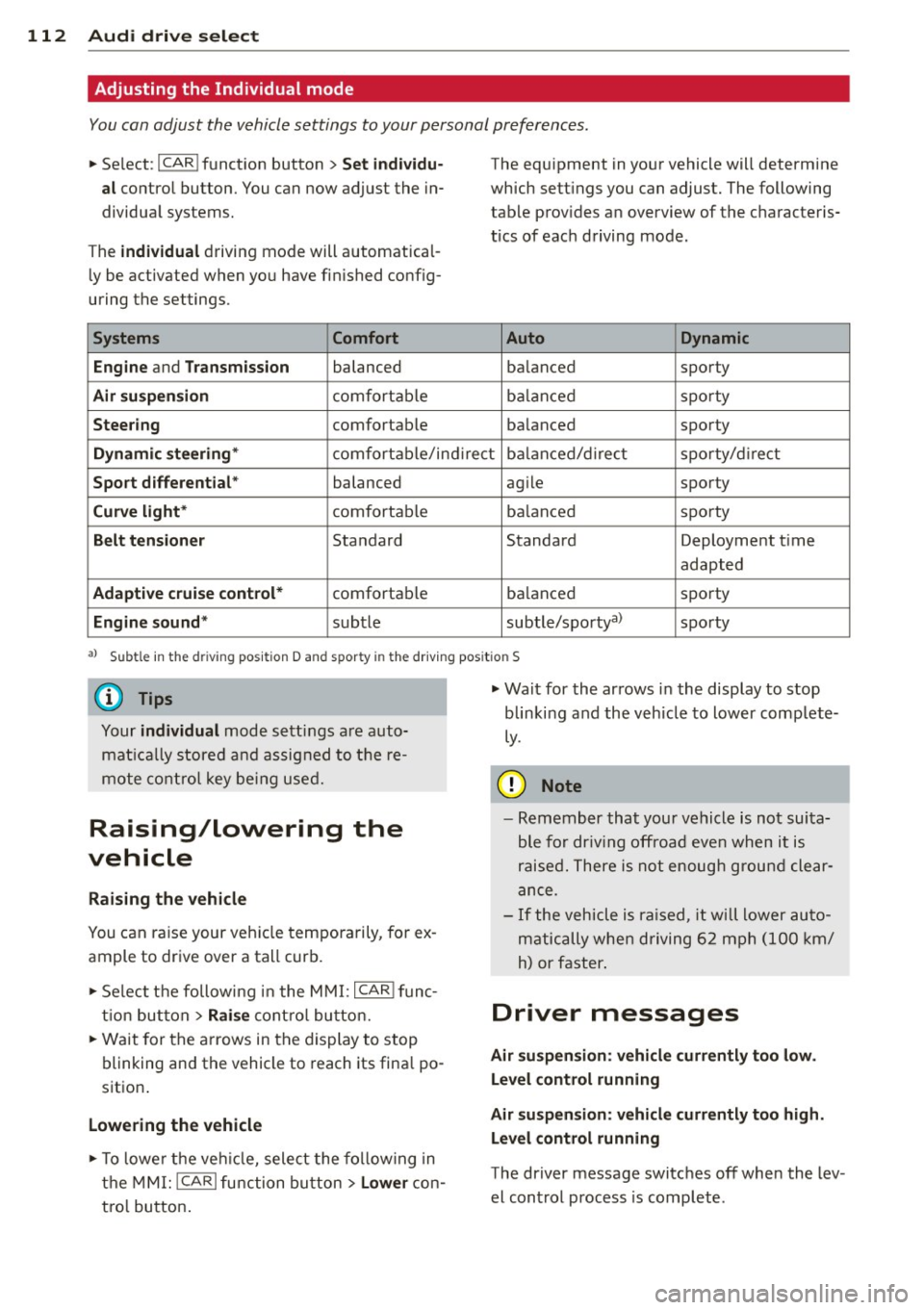
112 Audi drive select
Adjusting the Individual mode
You can adjust the vehicle settings to your personal preferences .
• Se lect : I CAR ! function button > Set individu
al
control button. You can now adjust the in
dividual systems.
The
individual driving mode will automatical
ly be activated when you have finished config
uring the settings .
Systems Comfort
Engine
and Transmission balanced
Air suspension comfortable
Steering comfortable The equipment
in your vehicle will determine
which settings you can adjust. The following
table provides an overview of the characteris
tics of each driving mode.
Auto Dynamic
balanced sporty
balanced sporty
balanced sporty
Dynamic steering* comfortable/indirect balanced/direct sporty/direct
Sport differential * balanced agile sporty
Curve light* comfortable balanced sporty
Belt
tensioner Standard Standard Deployment time
adapted
Adaptive cruise control* comfortable
balanced sporty
Engine
sound* subtle subtle/sportya> sporty
a) Subt le in th e d riv ing posi tion D an d sp or ty in the driving pos itio n S
(D Tips
Your individual mode settings are auto
matically stored and assigned to the re
mote control key being used.
Raising/lowering the
vehicle
Raising the vehicle
You can raise your vehicle temporarily, for ex
ample to drive over a tall curb .
• Se lect the following in the MMI:
I CAR I func
tion button
> Raise control button.
• Wait for the arrows in the display to stop
blinking and the vehicle to reach its final po
sition .
Lowering the vehicle
• To lower the veh icle, select the following in
the MMI:
ICARI function button > Lower con
tro l button. •
Wait for the arrows in the display to stop
blinking and the vehicle to lower comp lete
ly.
0 Note
- Remember that your vehicle is not suita
ble for driv in g offroad even when it is
raised. There is not enough ground clear
ance.
- If the vehicle is raised, it will lower auto
matically when driving 62 mph (100 km/
h) or faster .
Driver messages
Air suspension: vehicle currently too low.
Level control running
Air suspension: vehicle currently too high.
Level control running
The driver message switches off when the lev
el control process is complete .
Page 126 of 314
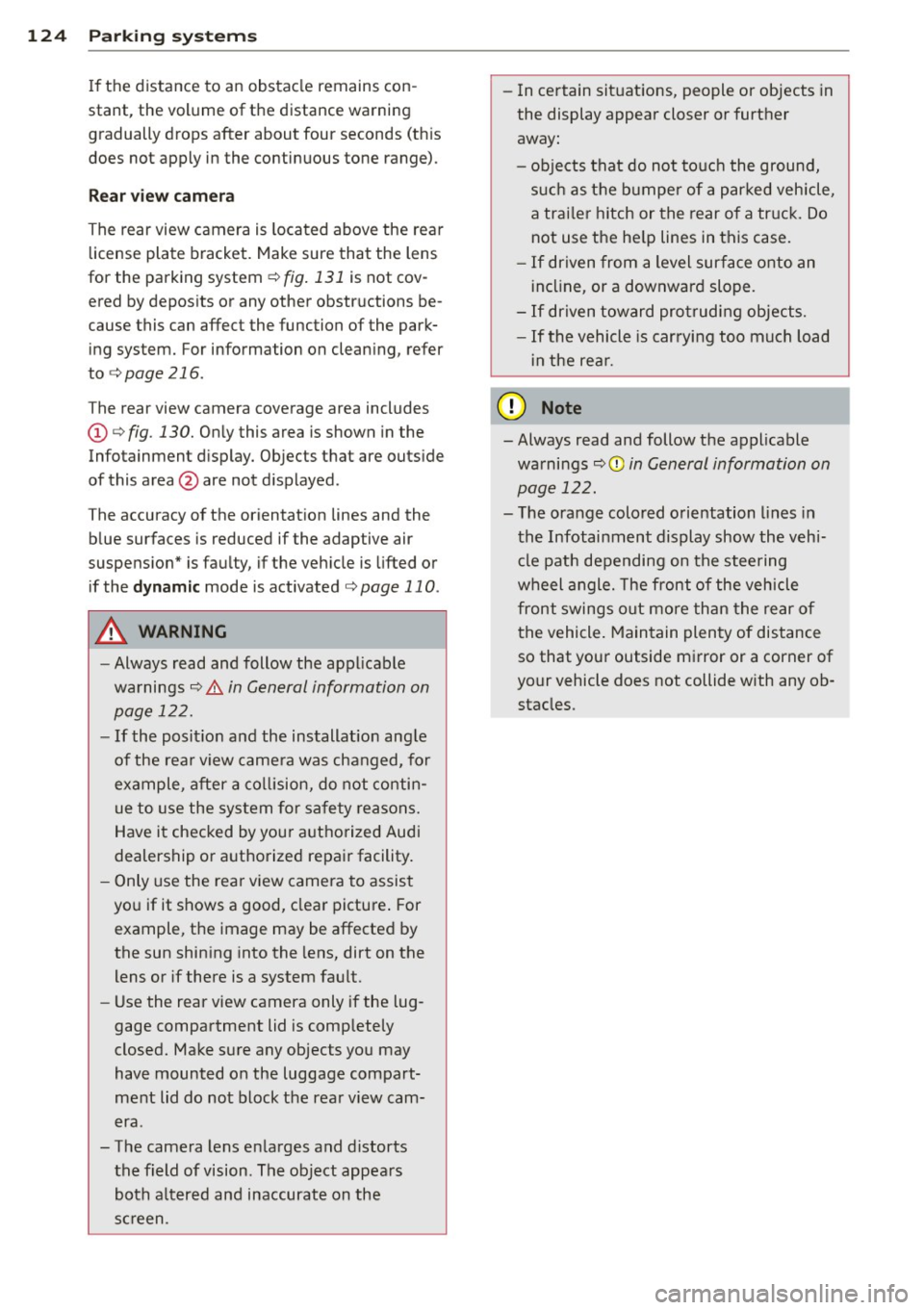
124 Parking systems
If the distance to an obstacle remains con
stant, the volume of the distance warning
gradually drops after about four seconds (this
does not apply in the continuous tone range).
Rear view camera
The rear view camera is located above the rear
license plate bracket. Make sure that the lens
for the parking system¢
fig. 131 is not cov
ered by deposits or any other obstructions be
cause this can affect the function of the park
ing system. For information on cleaning, refer
to
¢ page 216.
The rear view camera coverage area includes
(D ¢ fig. 130. Only this area is shown in the
Infotainment display. Objects that are outside
of this area@are not displayed.
The accuracy of the orientation lines and the blue surfaces is reduced if the adaptive air
suspension" is faulty, if the vehicle is lifted or
if the
dynamic mode is activated¢ page 110.
A WARNING
-Always read and follow the applicable
warnings¢ .&.
in General information on
page 122.
- If the position and the installation angle
of the rear view camera was changed, for
example, after a collision, do not contin
ue to use the system for safety reasons.
Have it checked by your authorized Audi
dealership or authorized repair facility.
- Only use the rear view camera to assist
you if it shows a good, clear picture. For
example, the image may be affected by
the sun shining into the lens, dirt on the
lens or if there is a system fault.
- Use the rear view camera only if the lug
gage compartment lid is completely
closed. Make sure any objects you may
have mounted on the luggage compart
ment lid do not block the rear view cam
era .
- The camera lens enlarges and distorts
the field of vision. The object appears both altered and inaccurate on the
screen. -
In certain situations, people or objects in
the display appear closer or further
away:
- objects that do not touch the ground,
such as the bumper of a parked vehicle,
a trailer hitch or the rear of a truck. Do
not use the help lines in this case.
- If driven from a level surface onto an
incline, or a downward slope.
- If driven toward protruding objects.
-If the vehicle is carrying too much load
in the rear.
{[) Note
-Always read and follow the applicable
warnings
c::> (D in General information on
page 122.
- The orange colored orientation lines in
the Infotainment display show the vehi
cle path depending on the steering
wheel angle. The front of the vehicle
front swings out more than the rear of
the vehicle. Maintain plenty of distance
so that your outside mirror or a corner of
your vehicle does not collide with any ob stacles.
Page 129 of 314

long side of the blue surface so that there is
suff icient space from the obstacle. The sur
face must not be touch ing. You will also need
to start turning the steer ing whee l much ear
lier. The blue curve
¢ fig . 13 7 must not to uch
the obstacle and should have sufficient room .
@ Tips
The left or right orientation lines and sur
faces will be displayed, depend ing on the
turn signa l bei ng used.
Peripheral cameras
Introduction
Applies to vehicles: with top view camera system
In addit ion to the functions from the sensors
¢ page 123, Sensors,¢ page 125 , Visual dis
play,
this parking system conta ins peripheral
cameras. Depending on the ve hicle equip
ment, you are assis ted by various views such
as peripheral view, corner views at the front
and rear of the veh icle, and views d irectly in
fro nt of o r behind the vehicle.
General information
App lies to vehicles: with top view camera system
Fig. 138 Loca tion of per ipheral came ras
Depending on the vehicle equ ipment, the pe
riphera l cameras are fou nd i n the radiator
grille, in the luggage compartment lid and on both exterior mirrors ¢
fig. 138 . Make sure
that the lenses are no t covered by deposits or
any other obstructions as it may impair the
sys tem. For information on cleaning, refer to
¢ page 216.
P arking sys tems 127
In the to p view mode, b lack corners are
shown in the ve hicle silhouette . Objects in
these areas are outside of the camera 's field
of view and are not detected .
T he accuracy of the orientation lines and the
bl ue surfaces is reduced if the adaptive air
suspension * is faulty, if the vehicle is lifted or
if the
dynamic mode is activated ¢ page 110.
A WARNING
- Always read and follow the applicable
warn ings ¢
& in General information on
page 122.
- If the position or the installat io n angle
of a camera was changed , after a colli
sion for example, do not continue to use
the system fo r safety reaso ns. Have i t
checked by you r author ized Audi dealer
sh ip .
- Keep in mind tha t the image in the dis
pl ay is distorte d if the exterior mirror
housing has bee n manually a dju sted .
- Use the
rear mode and the c orner view
( rear )
mode only when the luggage com
partment lid is fu lly closed . Otherwise
the image in the disp lay will be d istort
ed .
- T he vehicle surro undings are shown us
ing the came ra images. The veh icle im
age is shown by the system. Objects and
obstacles above the camera are not d is
p layed.
- Camera lenses enlarge and distort the fie ld of vision . T he objects appear both
altered and inaccurate on the sc reen.
(D Note
- Always read and follow the ap plicable
warnings
¢(Din General information on
page 122.
- The Infotainment d isp lay shows the di
rection in which the rear of the vehicle is
traveling based on the steer ing whee l
ang le . The front of the vehicle front
swings out more than the rear of the ve
hicle . Maintain plenty of d istance so that
IJJ,,
Page 170 of 314

168 Airbag system
and safety belts with pretensioners are
scrapped, al l applicable laws and regula·
tions must be observed. Your authorized
Audi dea ler is familiar with these require·
ments and we recommend that you have
your dealer perform this service for you .
Other things that can affect Advanced
Airbag performance
Changing the vehicle's suspension system can
change the way that the Advanced Airbag Sys
tem performs in a crash. For example, using
tire-rim combinations not approved by Audi, lowering the vehicle, chang ing the stiffness of
the suspension, including the spring s, suspen
sion struts, shock absorbers etc. can change
the forces that are measured by the a irbag
sensors and sent to the electronic control
unit . Some suspension changes can, for exam
ple, increase the force levels measured by the
sensors and make the airbag system deploy in
crashes in which it would not deploy if the
changes had not been made. Other kinds of
changes may reduce the force levels meas
ured by the sensors and prevent the airbag
from deploying when it should.
The sensors in the safety belt buckle for the
driver and front passenger seat tell the elec
tronic control module if the safety belt is
latched or not. If the safety belt is being used,
the front airbag will deploy at a slightly high
er rate of vehicle deceleration than if the safe
ty belt is not being used . Therefore, in a par
ticular collision, it is possible that an airbag
will not deploy at a seating position where the
safety belt is being used but will inflate at the
position where the safety belt is not being
used . It is important that nothing interfere
with the safety belt buckles so that the sen
sors can send the correct information about
safety belt use to the electronic control unit.
A WARNING
Changing the vehicle's suspension includ
ing use of unapproved tire-rim combina
tions can change Advanced Airbag per-formance and increase the risk of serious
personal injury in a crash.
- Never install suspension components
that do not have the same performance
characteristics as the components origi nally installed on your vehicle.
- Never use tire-rim combinations that
have not been approved by Audi.
A WARNING
--
Items stored between the safety belt buckle and the center console can cause
the sensors in the buckle to send the
wrong information to the e lectronic con
trol module and prevent the Advanced Air
bag System from working properly.
- Always make sure that nothing can inter
fere with the safety belt buckles and that
they are not obstructed .
Knee airbags
Description of knee airbags
The knee airbag system con provide supple
mental protection to properly restrained
front seat occupants.
Fig. 169 Driver 's knee airbag
The driver knee airbag is in the instrument
panel underneath the steering wheel
¢ fig . 169, the airbag for the passenger is at
about the same height in the instrument pan
el underneath the glove compartment.
The knee airbag offers additional protection
to the driver's and passenger's knees and up
per and lowe r th igh areas and supplements
the protection provided by the safety belts. ..,.
Page 211 of 314
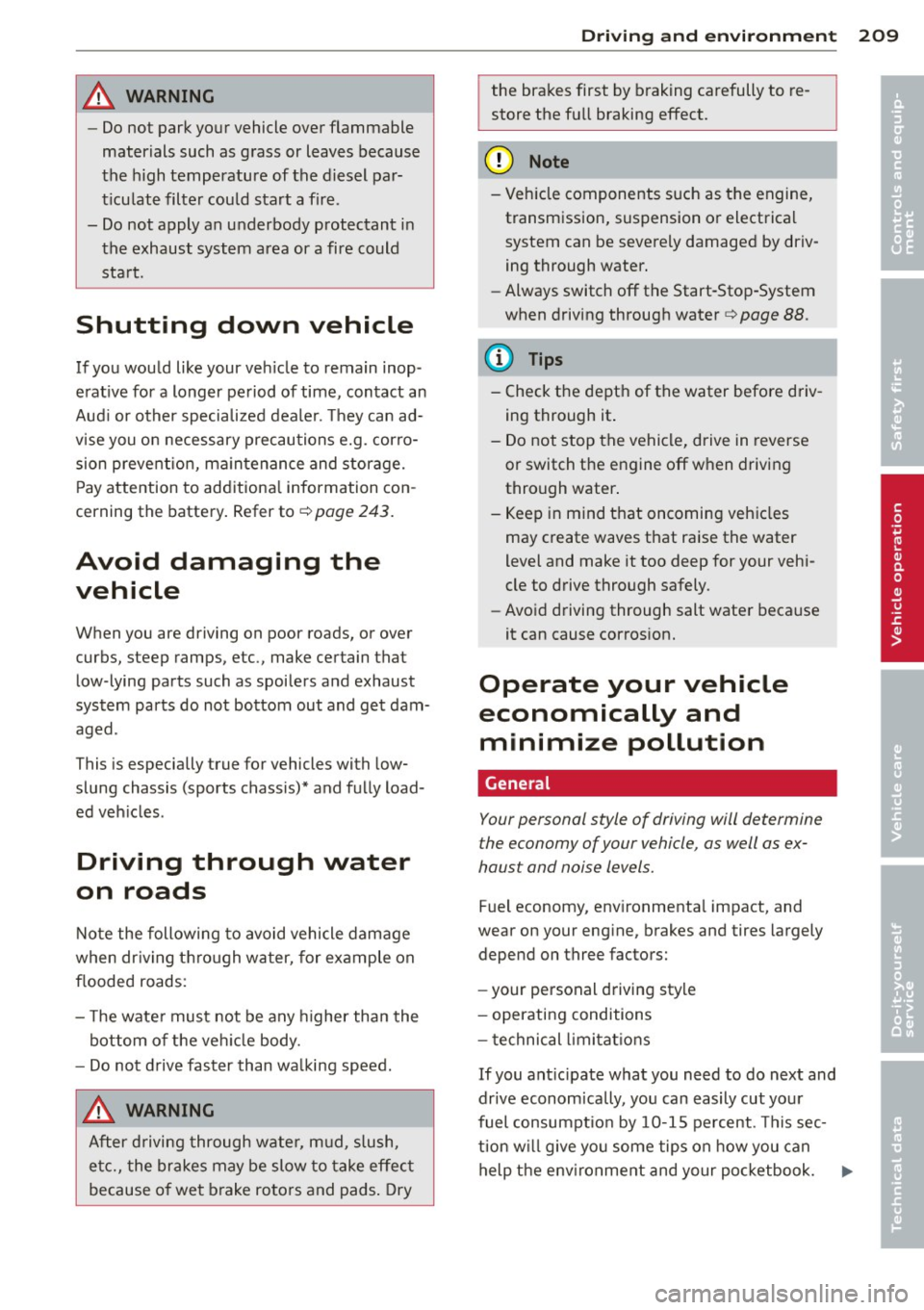
A WARNING ,~
- Do not park your vehicle over flammable
materials such as grass or leaves because
the high temperature of the diesel par
t icu late filter cou ld start a fire .
- Do not apply an underbody protectant in the exhaust system area or a fire could start .
Shutting down vehicle
If you would like your veh icle to remain inop
erat ive for a longer period of time, contact an
Aud i or other specia lized dealer. They can ad
vise you on necessary precautions e.g . corro
sion prevention, ma intenance and storage.
Pay attention to additiona l information con
cerning the battery. Refer to~
page 243.
Avoid damaging the
vehicle
When you a re driving on poor roads, or over
curbs, steep ramps, etc., make certain that low-lying parts such as spoilers and exhaust
system parts do not bottom out and get dam
aged.
This is especially true for vehicles with low
slung chassis (sports chassis)* and fully load
ed vehicles.
Driving through water
on roads
Note the following to avoid vehicle damage
when driving through water, for example on
flooded roads :
- The water must not be any higher than the
bottom of the veh icle body.
- Do not drive faster than wa lking speed.
A WARNING
After driving through water, mud, slush,
etc., the brakes may be slow to take effect
because of wet brake rotors and pads. Dry
-
Drivin g and environment 209
the brakes first by braking carefully to re
store the full braking effect.
(D Note
- Vehicle components such as the engine,
transmission, suspension or electrical
system can be severely damaged by driv
ing through water.
- Always switch off the Start-Stop-System
when driving through water~
page 88.
(D Tips
-Check the depth of the water before driv
ing through it .
- Do not stop the vehicle, drive in reverse
or switch the engine off when driving
through water.
- Keep in mind that oncoming vehicles may create waves that raise the water
level and make it too deep for your vehi
cle to drive through safely .
- Avoid driving through salt water because
it can cause corrosion.
Operate your vehicle
economically and minimize pollution
General
Your personal style of driving will determine
t he economy of your vehicle , as well as ex
haus t and noise levels.
Fuel economy, environmental impact, and
wear on your engine, brakes and tires largely
depend on three factors:
- your personal driving style
- operating conditions
- technical limitations
If you ant icipate what you need to do next and
drive econom ically, you can easily cut your
fuel consumpt ion by 10-15 percent . Th is sec
tion w ill give you some tips on how you can
help the env ironment and your pocketbook. •
•